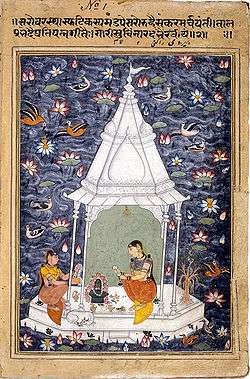Bhairav (raga)
Bhairav is an Indian classical raga of Bhairav thaat. It is a sampurna raga traditionally performed in the morning and also as the beginning piece in concerts. It is the defining raga of its own thaat.
 | |
| Thaat | Bhairav |
|---|---|
| Type | Sampurna |
| Time of day | Daybreak;[1] Beginning of concerts |
| Arohana | Sa Re Ga Ma Pa Dha Ni Sa/Sa Ga Ma Dha Ni Sa |
| Avarohana | Sa Ni Dha Pa Ma Ga Re Sa |
| Pakad | Ga Ma Dha Dha Pa, Ga Ma Re Re Sa |
| Chalan | Sa Ga Ma Pa Dha Dha Pa Ma Ga Ma Re Sa |
| Vadi | Dha |
| Samavadi | Re |
| Equivalent | Mayamalavagowla |
| Similar |
|
Raga Kalingda in Hindustani and Ragam Mayamalavagowla in Carnatic music have the same scale as Raga Bhairav, although the moods they create can be quite different due to the way they are expounded.
History
Bhairav raga is an ancient raga that is considered to be extremely old and originated many centuries ago. The origin of Bhairav raga is disputed. According to some musicians, Bhairav raga was the first raga that originated from the mouth of Lord Shiva. While some musicians argue that Bhairav raga originated from the mouth of Lord Surya. That's why it is sung in daytime.
Theory
Bhairav is grave in mood and suggests seriousness, introversion as well as devotional attitude. It shares its notes with Ahir Bhairav which has a sombre temperament.
Arohana : Sa Re Ga Ma Pa Dha Ni Sa/Sa Ga Ma Dha Ni Sa
Avarohana : Sa Ni Dha Pa Ma Ga Re Sa
Vadi : Dha Samvadi : Re
Pakad : Ga Ma Dha Dha Pa, Ga Ma Re Re Sa Chalan : Sa Ga Ma Pa Dha Dha Pa Ma Ga Ma Re Sa
Behaviour
The performance for this raga is solemnly serious. The raga comes across as a musical entity with mood of meditation, philosophical depth and emotional richness.
Samay (Time)
Bhairav is an early morning (pratham prahar) raag.
Seasonality
Bhairav is one of few ragas that can be sung in any season.
Rasa
Bhairav is typically performed with a peaceful, serious, and serene mood.
Film Songs
Bhairav is a popular raga for film songs. Here are some film songs based on Bhairav:
- "Amma Roti De Baba Roti De" - Sansar, 1952
- "Hanse Tim Tim" - Sansar, 1952
- "Mohe Bhul Gaye Sanvariya" - Baiju Bawra, 1952
- "Jaago, Mohan Pyare Jaago" - Jagte Raho, 1956
- "Man Re Hari Ke Gun Ga" - Musafir, 1957
- "Meri Veena Tum Bin Roye" - Dekh Kabira Roya, 1957
- "Kehe Do Koi Na Kare Yahan Pyaar" - Gunj Uthi Shehenai 1959
- Main Toh Ek Khwab Hoon" - Himalaya Ki Godh Mein 1965
- Waqt Karta Jo Wafa" - Dil Ne Pukara 1967
References
Sources
- Bor, Joep; Rao, Suvarnalata (1999). The Raga Guide: A Survey of 74 Hindustani Ragas. Nimbus Records with Rotterdam Conservatory of Music. p. 32. ISBN 9780954397609.CS1 maint: ref=harv (link)
- Bhairav Rāga (Hin), The Oxford Encyclopaedia of the Music of India. Oxford University Press. ISBN 9780195650983. Retrieved 11 October 2018.
